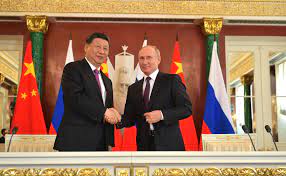Subscribe
Subscribe Now to receive Goldsea updates!
- Subscribe for updates on Goldsea: Asian American Supersite


An agreement by Russia to sell China two dozen advanced Su-35 fighters and advanced fighter-jet engines suggests the two nations may be resuming the military and technical cooperation interrupted over two years ago, according to Moscow-based Opinions.
The deal signed on November 21 by Hu Jintao and Russian Defense Minister Sergey Shoygu calls for the sale of 24 Su-35 fighters valued at $1.5 billion, as well as an unspecified number of 117S (Saturn NPO’s Al-41F-1S) turbofan engines.
This agreement to sell to China Russia’s most advanced export fighter jet suggests that Moscow has overcome reservations about the copyright infringement that had caused it to suspend sales of key weapons systems and components to China in 2010. One of those components is believed to be the arresting mechanism used for landing fighter jets on aircraft carriers, causing a delay in the deployment of the Liaoning, China’s first aircraft carrier, while China developed its own mechanism.
The breach between the two nations began in March of 2010 when Russia accused China of having violated a licensing agreement by building knockoffs of the Sukhoi-27 fighter as the J11-B — a plane described by one military analyst as “simply a Russian design stuffed with local electronics.”
China had acquired the plane’s blueprints and specs in 1995 when it agreed to buy 200 kits to assemble the plane in China under license. But in 2004, after 100 of the planes had been built, China cancelled the contract for the remaining 100 kits claiming the plane no longer met the PLA Air Force’s new performance requirements.
That cancellation was followed by China’s efforts to sell the J-11B fighter jets to other nations, directly competing with Russia’s own armament export industry. Currently versions of the J-11B continue to be built at the Shenyang Aircraft Corporation (SAC) which had once assembled the Su-27K kits.
Military technical cooperation between China and Russia has had a checkered history since it began in 1949 with the founding of the PRC. In the ensuing decade the Soviet Union provided China with the blueprints for tanks, missiles, bombers, submarines and destroyers. The 1960 breach in Soviet-Chinese relations triggered a series of border conflicts and ended the military cooperation. But Chinese engineers continued to reverse engineer Soviet-era weapons. The HN-5 portable air-defense system, based on the Soviet SA-7A missile, was sold by China to Vietnam, Pakistan and Afghanistan, among other nations. Afghan mujahadeen used them to devastating effect against Russian planes during the 1980s.
Cooperation resumed after the collapse of the Soviet Union in 1991, mainly because Russia was in dire needed of export revenues and the arms industry was the only one competitive with the west. During this era China was able to acquire more sophisticated Russian arms with which to upgrade its Cold-War era weapons.
By the late 1990s China was able to make cheaper versions of Russian weapons systems and build its own thriving arms-export industry. Cost advantages allowed China to outcompete Russia with most third-world arms clients. Among the knockoffs were the J-11 and J-15 based on the the Russian Su-27 and Su-33. Hundreds of Russian engineers found lucrative employment in helping China develop homegrown versions of Russian technology.
The rapid progress of China’s arms industry put Russia in a quandry. Continuing to deny is more advanced weapons system to China would risk alienating an increasingly rich and powerful neighbor who would in any event catch up within a decade. If it resumed selling the weapons, it would help strengthen a potential military rival and accelerate the erosion of its arms export market.
The fact that sales of its advanced weaponry to China is resuming suggests that Moscow has concluded that strengthening cooperation with Beijing will provide more economic and political benefit than trying to preserve its dwindling arms technology lead.
